Spatiotemporal Evolution and Driving Factors of Coupling Coordination Degree Between New Urbanization and Urban Resilience: A Case of Huaihai Economic Zone
Abstract
1. Introduction
2. Materials and Methods
2.1. Theoretical Mechanism Analysis
2.2. Research Framework
2.3. Study Area and Data Sources
2.4. Construction Evaluation Index Systems
2.4.1. New Urbanization Evaluation System
2.4.2. Urban Resilience Evaluation System
2.5. Research Methods
2.5.1. Entropy Weight–CRITIC Method
2.5.2. The CCD Model
2.5.3. Grey Relational Analysis
3. Results and Discussion
3.1. Spatiotemporal Evolution Characteristics of New Urbanization and Urban Resilience
3.1.1. Temporal Evolution of New Urbanization and Urban Resilience
3.1.2. Spatial Pattern Analysis of New Urbanization and Urban Resilience
3.2. Spatiotemporal Evolution of the CCD Between New Urbanization and Urban Resilience
3.2.1. Temporal Evolution of the CCD Between New Urbanization and Urban Resilience
3.2.2. Spatial Evolution of the CCD Between New Urbanization and Urban Resilience
3.3. Key Driving Factors for the CCD Between New Urbanization and Urban Resilience
4. Conclusions and Suggestions
4.1. Main Conclusions
- (1)
- The development indices of new urbanization construction and urban resilience development. In terms of time series evolution, the new urbanization and urban resilience in the HEZ showed a steady upward trend from 2013 to 2023, and the growth rate of urban resilience was slightly higher than that of new urbanization. During the study period, the new urbanization construction index ranged between 0.30 and 0.47, the development level was relatively low, and there was still further improvement. The urban resilience development index ranged between 0.35 and 0.64, with the initial achievements in development. In terms of spatial evolution, the new urbanization generally presents the spatial characteristics of a “north–high, south–low” spatial pattern, and the distribution of urban resilience develops from regional distribution to regional overall improvement. Core cities like Xuzhou, Linyi, and Jining exhibited high levels of new urbanization construction and urban resilience development, with diminishing gradients toward peripheral areas, particularly weak in southern marginal cities.
- (2)
- The CCD between new urbanization and urban resilience. In the temporal evolution, the CCD of cities in the HEZ fluctuates upward, the overall horizontal interval span is small, and the development of cities is relatively balanced. In terms of spatial evolution, the HEZ generally presents a pattern of high aggregation and coordinated development. In 2013, only Suzhou was categorized as imbalanced, and the rest of the cities were coordinated types. The coordination type of the CCD has experienced evolution from primary coordination to good coordination, and the coordination type of cities presents a patchy distribution, which benefits from the great efforts made by regional cities in transportation interconnection and industrial cooperation.
- (3)
- Key driving factors affecting the CCD. As the core driving factors affecting the coordinated development of new urbanization and urban resilience, the economic development level, public service capacity, and municipal resilience level (correlation degree >0.7) promote their coordinated development through industrial transformation and upgrading, the rational allocation of public resources, and the improvement of municipal resilience facilities. Infrastructure construction and digitalization capacity improve the CCD by optimizing transportation network layout and strengthening smart city governance, respectively. Spatial intensity reveals regional differences in urban land resource allocation efficiency, which requires regional differential management to balance polarization effects and prevent inefficient development and utilization. Due to insufficient investment, ecological governance capacity (correlation degree is 0.5410) has become a key weakness affecting coordinated development. Urban ecological environment governance projects and regional ecological collaborative protection projects should be continuously carried out to constantly improve the regional ecological compensation mechanism.
4.2. Suggestions for Optimization
- (1)
- Border depression effect in resource allocation. The provincial allocation of construction land quotas has created a paradoxical phenomenon in inter-provincial border areas (e.g., the Xuzhou–Suzhou junction zone), characterized by duplicative infrastructure construction alongside public service vacuums. Industrial funds from the four provinces predominantly concentrate on provincial capitals and hinterland cities, resulting in restricted capital mobility. Consequently, infrastructure investment within the HEZ remains insufficient, with cross-provincial infrastructure projects accounting for a disproportionately small share of total investment.
- (2)
- Responsibility evasion dilemma in ecological governance. Transboundary rivers such as the Yi River and Shu River exhibit fragmented watershed management due to the “upstream pollution, downstream remediation” conflict. Furthermore, disaster prevention facilities operate within provincially isolated systems, exemplified by the non-interoperability between Shandong’s rainstorm early warning systems and Jiangsu’s emergency response platforms. This institutional fragmentation creates “resilience facility islands” that impede coordinated cross-regional disaster response.
- (3)
- Implementation challenges in policy coordination. The pollution remediation standards for industrial land in different provinces are different, and the environmental protection standards are also inconsistent, which has led to the migration of high polluting enterprises to low standard areas. The mismatch of assessment incentives has led to a higher weight of GDP assessment in various provinces and cities, while less attention is paid to urban resilience, which promotes the short-term behavior of “rebuilding and neglecting protection”.
- (1)
- Construct a new urbanization construction system with gradient linkage. Due to the imbalance of economic and social development among regional cities, the transformation and upgrading paths of cities are also different. It is necessary to rely on the core driving force and comparative advantages of cities, clarify the functional orientation of cities, and establish a gradient development mode of “core leading function–complementary characteristic linkage”. Firstly, strengthen the radiation efficiency of core cities, build core leading cities with Xuzhou, Jining, and Linyi as the core, and build a Xuzhou–Jining–Linyi innovation axis. Xuzhou focuses on the development of high-end equipment manufacturing and industrial innovation clusters and radiates technical resources southward in conjunction with university research institutes; Jining relies on ecological resources to develop an ecological economy, builds ecological restoration demonstration bases in the lower reaches of the Yellow River, and explores the resource replacement mechanism of “ecological bank”; Linyi builds a commercial logistics trade hub in the HEZ and builds a digital supply chain platform covering southern Shandong and northern Jiangsu. Secondly, improve the regional function supplement. Lianyungang should focus on the construction of automated container terminals and sea–rail intermodal intelligent dispatching systems, and develop port-based bulk commodity trading centers; Zaozhuang and Huaibei should explore the transformation and development paradigm of resource-based cities, focus on cultivating new energy battery materials and industrial solid waste recycling industries, and promote the transformation of old industrial zones. Finally, strengthen the characteristic linkage development. Suzhou and Suqian should build smart agriculture and characteristic agriculture demonstration zones by introducing an agricultural Internet of Things management system; Shangqiu and Heze should rely on high-speed rail hubs to build cross-border e-commerce comprehensive experimental zones, supporting “one-stop” cross-border trade service platforms, and creating a gateway to the opening up of Central Plains Urban Agglomerations, thereby restructuring traditional industrial path dependence.
- (2)
- Implement a precise reinforcement strategy for resilience short boards. In the process of promoting new urbanization, population migration, industrial pollution, soil erosion, and other problems have caused serious oppression of ecological and municipal systems. Given the weak links of ecological and municipal systems, the resilient development strategy of “zonal governance and facility upgrading” should be adopted. On the one hand, differential management and control shall be carried out, the ecological red line shall be maintained, green and effective ecological resilience promotion means shall be implemented, and green ecological security development pattern shall be constructed. For example, the “development–restoration” linkage system should be implemented for resource-based cities such as Huaibei, Jining, and Xuzhou, focusing on measures such as mine re-greening, wetland reconstruction, and green infrastructure reconstruction. A compensation mechanism for the withdrawal of high-pollution and high-emission enterprises should be established, and the original site of the enterprise should be preferentially transformed into an emergency material reserve or disaster prevention park. On the other hand, municipal resilience facilities improvement projects and strengthening public emergency infrastructure construction should be carried out. Increase capital investment in urban municipal roads, underground pipe networks, emergency management, etc., and strengthen the ability of urban systems to withstand risks. In order to eliminate the edge effect, actively promote urban cooperation, simultaneously establish a regional compensation mechanism for resilient elements, and improve the resource integration and factor flow rate among cities. For example, ecological node urban ecological conservation areas can sell ecological quotas to regional industrial cities through carbon sink transactions to realize cross-regional transformation of ecological values.
- (3)
- Innovate regional collaborative governance mechanisms. Regional cities should further strengthen ecological environment governance, optimize infrastructure construction and public service allocation, and increase industrial transformation and upgrading, so as to enhance intra-regional coordination, and form a green and sustainable urban development model. Externally, based on the common interests of coordinated regional development, to stimulate regional vitality and development advantages. For example, Xuzhou, Jining, and other cities with high scientific and technological innovation levels should radiate their technological advantages to surrounding cities to improve the scientific and technological innovation level of surrounding cities. Resource-based cities such as Zaozhuang, Huaibei, and Suzhou should accelerate green transformation to provide resource support for surrounding cities. In addition, integrate data resources of 10 cities in the HEZ, build a unified “Huaihai Smart City Cloud Brain” to integrate multi-source data (urban geographic information, ecological information, social information and government data, etc.) for real-time monitoring, risk early warning, and intelligent resource dispatch, fostering a “regional linkage and technological empowerment” governance framework to achieve coordinated and sustainable urban management.
4.3. Research Limitations and Prospects
- (1)
- Limitations in multi-source data integration. Although the current evaluation systems constructed in the study cover multi-dimensional indicators such as economy, population, and smart, the data source is still mainly statistical data, which does not fully integrate multi-source heterogeneous data such as remote sensing images, real-time monitoring of the Internet of Things and social media, and may ignore high-precision spatiotemporal dynamic information [67,68]. The dimension of smart urbanization focuses on infrastructure coverage and lacks a dynamic evaluation of digital governance effectiveness and citizen participation. The reliance on single data sources risks compromising the comprehensiveness and timeliness of the indicator system.
- (2)
- Insufficient analysis of regional disparity mechanisms. Although the study reveals the “north–high, south–low” pattern and core–periphery disparities in the CCD between new urbanization and urban resilience in the HEZ, there is a lack of quantitative analysis of the deep mechanism of the underlying mechanisms. In addition, although the grey relational analysis model identifies the influence ranking of driving factors, it does not reveal the spatial heterogeneity of driving forces in combination with spatial econometrics models (such as geographically weighted regression and spatial metrology model [54,82]), resulting in a less systematic explanation of the causes of regional differences.
- (3)
- Inadequate consideration of dynamic interactions and long-term effects. Although this study focused on the spatiotemporal evolution of the study area from 2013 to 2023, it did not include longer-period data or scenario simulations (such as climate change, policy interventions, path dependence, etc.), limiting the assessment of external shocks on the CCD over extended periods [17,21,40,61]. Additionally, the model does not consider the non-linear feedback mechanism between new urbanization and urban resilience, which may underestimate the complexity of system synergy. The grey relational analysis model mainly detects monotonic relationships, which may overlook complex non-linearities and is not suitable for systems with threshold effects. In terms of analyzing the key factors influencing the CCD, considering the limitations of the existing linear models, it is important to further explore the use of non-linear models (such as random forests, ridge regression, etc.) to more accurately reveal the mechanisms of action of each factor and provide a more robust theoretical basis for regional safety resilience and sustainable development.
- (4)
- Methodology transferability framework. The proposed methodology is transferable to regions confronting analogous challenges of urbanization–resilience coordination (e.g., Hohhot–Baotou–Ordos–Yulin region, northern Slope of Tianshan Mountain in Xinjiang, Changsha–Zhuzhou–Xiangtan Metropolitan Circle, and western Taiwan Straits Economic Zone). However, context-specific adaptations are essential. For resource-based regions (e.g., Hohhot–Baotou–Ordos–Yulin region), increase the weights of industrial transformation and ecological governance in both new urbanization and urban resilience systems to reflect mining impacts on sustainable development [27]. For data-scarce areas (e.g., northern Slope of Tianshan Mountain), adopt simplified indicator systems as low-cost alternatives. For data-rich zones (e.g., western Taiwan Straits Economic Zone), leverage multi-source metrics such as nighttime light intensity to invert economic urbanization levels, or design context-specific indicators to avoid mechanistic application of the framework [56,61,77]. Additionally, dynamic threshold calibration is necessary. While linear CCD divisions are pragmatic, future work should calibrate region-specific thresholds using clustering algorithms. The CCD classification thresholds (e.g., 0.6 for intermediate coordination) must be recalibrated based on regional baseline conditions [21,35,83]. This ensures spatial sensitivity and methodological adaptability.
Author Contributions
Funding
Data Availability Statement
Acknowledgments
Conflicts of Interest
References
- Yao, S.; Zhang, P.; Yu, C.; Li, G.; Wang, C. The theory and practice of new urbanization in China. Sci. Geogr. Sin. 2014, 34, 641–647. [Google Scholar] [CrossRef]
- Sun, G. New urbanization: Development evolution, strategic thinking and institutional supply. Economist 2025, 3, 77–86. [Google Scholar] [CrossRef]
- Li, B.Q.; Chen, C.L.; Hu, B.L. Governing urbanization and the New Urbanization Plan in China. Environ. Urban 2016, 28, 515–534. [Google Scholar] [CrossRef]
- Guan, X.; Wei, H.; Lu, S.; Dai, Q.; Su, H. Assessment on the urbanization strategy in China: Achievements, challenges and reflections. Habitat Int. 2018, 71, 97–109. [Google Scholar] [CrossRef]
- Leichenko, R. Climate change and urban resilience. Curr. Opin. Environ. Sustain. 2011, 3, 164–168. [Google Scholar] [CrossRef]
- Shamsuddin, S. Resilience resistance: The challenges and implications of urban resilience implementation. Cities 2020, 103, 102763. [Google Scholar] [CrossRef]
- Mallick, S.K.; Das, P.; Maity, B.; Rudra, S.; Pramanik, M.; Pradhan, B.; Sahana, M. Understanding future urban growth, urban resilience and sustainable development of small cities using prediction-adaptation-resilience (PAR) approach. Sustain. Cities Soc. 2021, 74, 103196. [Google Scholar] [CrossRef]
- Amirzadeh, M.; Sobhaninia, S.; Sharifi, A. Urban resilience: A vague or an evolutionary concept? Sustain. Cities Soc. 2022, 81, 103853. [Google Scholar] [CrossRef]
- Shan, Z.; Huang, Y. An analysis of the concept, goals, contents, planning strategies and misunderstandings of new urbanization. Urban Plan. Forum 2013, 2, 16–22. [Google Scholar]
- Fang, C. Basic rules and key paths for high-quality development of the new urbanization in China. Geogr. Res. 2019, 38, 13–22. [Google Scholar]
- Chen, C.K.; Xu, L.L.; Zhao, D.Y.; Xu, T.; Lei, P. A new model for describing the urban resilience considering adaptability, resistance and recovery. Saf. Sci. 2020, 128, 104756. [Google Scholar] [CrossRef]
- Zeng, X.; Yu, Y.C.; Yang, S.; Lv, Y.; Sarker, M.N.I. Urban Resilience for Urban Sustainability: Concepts, Dimensions, and Perspectives. Sustainability 2022, 14, 2481. [Google Scholar] [CrossRef]
- Datola, G. Implementing urban resilience in urban planning: A comprehensive framework for urban resilience evaluation. Sustain. Cities Soc. 2023, 98, 104821. [Google Scholar] [CrossRef]
- Tang, H.; Yang, M.; Li, M.; Zhang, L.; Shao, Z. Research on coupling coordination of urban resilience and new-type urbanization in the Shandong Peninsula Urban Agglomeration. Areal Res. Dev. 2024, 43, 85–90+126. [Google Scholar]
- Fan, H.; Zhao, C. Research on the coupling coordination relationship between urbanization and ecological resilience in southwest China. Res. Soil Water Conserv. 2025, 32, 340–352. [Google Scholar] [CrossRef]
- He, X.; Shi, C.; Peng, K. Spatial-temporal adaptation and interactive response of new-type urbanization and ecological resilience in the middle reaches of the Yangtze River. Resour. Environ. Yangtze Basin 2024, 33, 699–714. [Google Scholar]
- Li, Y.; Li, M. Coupling coordination, spatial-temporal patterns and dynamic impact of the new urbanization and ecological resilience in the Yangtze River Economic Belt. Resour. Environ. Yangtze Basin 2024, 33, 2329–2341. [Google Scholar]
- Zhou, C.; Zheng, X.; Yang, Q. Coevolution of new urbanization and rural revitalization and its citizenization effect. Geogr. Res. 2024, 43, 3265–3288. [Google Scholar]
- Shi, C.; He, X. Influence of environmental regulation on urban ecological resilience:a case study of urban agglomeration in the middle reaches of the Yangtze River. J. Shaanxi Norm. Univ. Nat. Sci. Ed. 2023, 51, 56–71. [Google Scholar] [CrossRef]
- Ou, J.; Xu, C.; Chen, D. High-quality development of new urbanization in Guangdong province: Spatio-temporal evolution, influencing factors. Econ. Geogr. 2023, 43, 78–87. [Google Scholar] [CrossRef]
- Gen, Y.; Li, X.; Chen, J.; Liu, X.; Zhang, J.; Cheng, J. Coupling relationship and transition mechanism between resilience and efficiency in China’s territorial space. Acta Ecol. Sin. 2024, 44, 6003–6019. [Google Scholar] [CrossRef]
- Tu, D.H.; Cai, Y.Y.; Liu, M.B. Coupling coordination analysis and spatiotemporal heterogeneity between ecosystem services and new-type urbanization: A case study of the Yangtze River Economic Belt in China. Ecol. Indic. 2023, 154, 110535. [Google Scholar] [CrossRef]
- Yang, C.; Zeng, W.; Yang, X. Coupling coordination evaluation and sustainable development pattern of geo-ecological environment and urbanization in Chongqing municipality, China. Sustain. Cities Soc. 2020, 61, 102271. [Google Scholar] [CrossRef]
- Wang, S.; Cui, Z.; Lin, J.; Xie, J.; Su, K. Coupling relationship between urbanization and ecological resilience in the Pearl River Delta. Acta Geogr. Sin. 2021, 76, 973–991. [Google Scholar]
- Guo, H.; Liu, X. Coupling and coordination mechanism of new urbanization and ecological resilience in central cities along the Yellow River. East China Econ. Manag. 2023, 37, 101–109. [Google Scholar] [CrossRef]
- Zhu, S.Y.; Feng, H.B.; Arashpour, M.; Zhang, F. Enhancing urban flood resilience: A coupling coordinated evaluation and geographical factor analysis under SES-PSR framework. Int. J. Disaster Risk Reduct. 2024, 101, 104243. [Google Scholar] [CrossRef]
- Jiang, Y.; Ouyang, J.; Zhang, J. Evolution of social-ecological system resilience and its mainobstacle factors in resource-based cities: A case study of Panzhihua. Resour. Sci. 2024, 46, 2064–2077. [Google Scholar]
- Han, S.; Wang, B.; Ao, Y.B.; Bahmani, H.; Chai, B.B. The coupling and coordination degree of urban resilience system: A case study of the Chengdu-Chongqing urban agglomeration. Environ. Impact Assess. Rev. 2023, 101, 107145. [Google Scholar] [CrossRef]
- Guo, H. The coupling and coordinated development of new-type urbanization and ecological resilience in Qingdao: Based on the comparison of the central cities along the Yellow River. J. China Univ. Pet. Ed. Soc. Sci. 2023, 39, 22–31. [Google Scholar] [CrossRef]
- Ma, H.; Chu, J.; Li, J. A study on the coupling coordination between urban resilience and urbanization in Anhui Province. World Surv. Res. 2023, 7, 28–37. [Google Scholar] [CrossRef]
- Mu, X.F.; Fang, C.L.; Yang, Z.Q. Spatio-temporal evolution and dynamic simulation of the urban resilience of Beijing-Tianjin-Hebei urban agglomeration. J. Geogr. Sci. 2022, 32, 1766–1790. [Google Scholar] [CrossRef]
- Wang, D.; Long, H.; Wang, K.; Wang, H.; Chai, H.; Gao, J. Coupling coordination analysis of urbanization intensity and ecological resilience in Beijing-Tianjin-Hebei. Acta Ecol. Sin. 2023, 43, 6321–6331. [Google Scholar]
- Li, S.; Liu, H. Spatio-temporal pattern evolution of coupling coordination between urbanization and ecological resilience in arid region: A case of Ningxia Hui Autonomous Region. Arid. Land Geogr. 2022, 45, 1281–1290. [Google Scholar]
- He, S.; Li, H.; Qin, M.; Wang, X.; Yang, Z. Spatial analysis of the coupling of new urbanization and urban resilience in China and research on its influencing factors. J. Henan Univ. Nat. Sci. 2024, 54, 540–553. [Google Scholar] [CrossRef]
- Liu, H.; Wang, G.; Zhang, P.; Wang, Z.; Zhang, L. Spatio-temporal evolution and coordination influence of coupling coordination between new urbanization and ecological resilience in Fenhe River Basin. J. Nat. Resour. 2024, 39, 640–667. [Google Scholar]
- Zhao, Z.; Hu, Z.; Han, X.; Chen, L.; Li, Z. Evaluation of Urban Resilience and Its Influencing Factors: A Case Study of the Yichang–Jingzhou–Jingmen–Enshi Urban Agglomeration in China. Sustainability 2024, 16, 7090. [Google Scholar] [CrossRef]
- Chen, M.; Gong, Y.; Lu, D.; Ye, C. Build a people-oriented urbanization: China’s new-type urbanization dream and Anhui model. Land Use Policy 2019, 80, 1–9. [Google Scholar] [CrossRef]
- Zhou, Q.; Liu, D. Study on the coordinated development of urban resilience and urbanization level in the urban agglomeration of Yangtze River Delta. Res. Soil Water Conserv. 2020, 27, 286–292. [Google Scholar] [CrossRef]
- Zhang, Y.; Liu, Q.; Li, X. Spatiotemporal evolution of the coupling coordination of urban resilience and new urbanization in the urban agglomeration of Yangtze River delta. Urban Probl. 2022, 5, 17–27. [Google Scholar] [CrossRef]
- Peng, K.J.; He, X.R.; Xu, C.X. Coupling Coordination Relationship and Dynamic Response between Urbanization and Urban Resilience: Case of Yangtze River Delta. Sustainability 2023, 15, 2702. [Google Scholar] [CrossRef]
- Li, H.Y.; Hu, C.X.; Zhu, M.Y.; Hong, J.R.; Wang, Z.J.; Fu, F.; Zhao, J.Q. Study on the coupled and coordinated development of urban resilience and urbanization level in the Yellow River Basin. Environ. Dev. Sustain. 2024. [Google Scholar] [CrossRef]
- Sun, J.; Zhai, N.N.; Mu, H.R.; Miao, J.C.; Li, W.X.; Li, M.F. Assessment of urban resilience and subsystem coupling coordination in the Beijing-Tianjin-Hebei urban agglomeration. Sustain. Cities Soc. 2024, 100, 105058. [Google Scholar] [CrossRef]
- He, G.; Yang, J.; Bao, K.; Zhou, Q. Analysis for the spatial correlation and the impact of the newly urbanized trend on the regional eco-environment quality. J. Saf. Environ. 2020, 20, 1958–1966. [Google Scholar] [CrossRef]
- Walker, B.; Holling, C.S.; Carpenter, S.R.; Kinzig, A.P. Resilience, Adaptability and Transformability in Social-ecological Systems. Ecol. Soc. 2004, 9, 5. [Google Scholar]
- Wan, Z.; Zhao, C.; Zhu, J.; Ma, X.; Chen, J.; Wang, J. Assessment and Prediction of Coastal Ecological Resilience Based on the Pressure–State–Response (PSR) Model. Land 2024, 13, 2130. [Google Scholar] [CrossRef]
- Song, Y.; Gao, Y.; Zhang, S.; Dong, H.; Liu, X. Research on the Coupling Coordination and Driving Mechanisms of New-Type Urbanization and the Ecological Environment in China’s Yangtze River Delta. Sustainability 2024, 16, 5308. [Google Scholar] [CrossRef]
- Huang, J.; Zhong, P.; Zhang, J.; Zhang, L. Spatial-temporal differentiation and driving factors of ecological resilience in the Yellow River Basin, China. Ecol. Indic. 2023, 154, 110763. [Google Scholar] [CrossRef]
- Liao, Z.; Zhang, L. Analyzing and predicting the urbanization and ecological resilience coupling and coordination of Guangdong Province. Humanit. Soc. Sci. Commun. 2024, 11, 1322. [Google Scholar] [CrossRef]
- Feng, X.; Zeng, F.; Loo, B.P.Y.; Zhong, Y. The evolution of urban ecological resilience: An evaluation framework based on vulnerability, sensitivity and self-organization. Sustain. Cities Soc. 2024, 116, 105933. [Google Scholar] [CrossRef]
- Zhou, M.; He, Q.; Gu, Y.; Wang, K.; Shen, Z. Urban Flood Resilience Assessment of Prefecture-Level Cities in Yangtze River Delta. ISPRS Int. J. Geo-Inf. 2025, 14, 108. [Google Scholar] [CrossRef]
- Yang, L.; Xu, Y.; Zhu, J.Q.; Sun, K.Y. Spatiotemporal Evolution and Influencing Factors of the Coupling Coordination of Urban Ecological Resilience and New Quality Productivity at the Provincial Scale in China. Land 2024, 13, 1998. [Google Scholar] [CrossRef]
- Wei, C.; Wu, Z.; Li, R.; Xing, J.; Zhang, M. Urbanization quality measurement and its coordinated development in counties of Hubei province. Econ. Geogr. 2023, 43, 95–105. [Google Scholar] [CrossRef]
- Yin, S.; Zhou, Y.; Zhang, C.; Wu, N. Impact of regional integration policy on urban ecological resilience: A case study of the Yangtze River Delta region, China. J. Clean. Prod. 2024, 485, 144375. [Google Scholar] [CrossRef]
- LÜ, L.; Kan, D. Interactive coupling and driving factors of new urbanization and water ecological resilience based on a study in Central China. Chin. J. Agric. Resour. Reg. Plan. 2025, 46, 103–116. [Google Scholar]
- He, Z.; Wu, Z.; Wang, Z.; He, R.; Ji, L.; Ma, C.; Deng, X. Path to peak emissions and smart urbanization. Urban Plan. Forum 2021, 6, 37–44. [Google Scholar] [CrossRef]
- Hou, L.; Cui, M. A new insight to investigate the developmental resilience of Chengdu-Chongqing twin-city economic circle based on ecological niche theory. J. Asian Archit. Build. Eng. 2024, 1–13. [Google Scholar] [CrossRef]
- Meerow, S.; Newell, J.P.; Stults, M. Defining urban resilience: A review. Landsc. Urban Plan. 2016, 147, 38–49. [Google Scholar] [CrossRef]
- Zhang, Z.X.; Bai, Y. Spatiotemporal Evolutionary Features and Disorder Factor Diagnosis of Urban Resilience. J. Urban Plan. Dev. 2024, 150, 05024031. [Google Scholar] [CrossRef]
- Yi, R.; Chen, Y.N.; Chen, A. Evaluating urban climate resilience in the Yangtze River Delta urban agglomeration: A novel method integrating the DPSIR model and Sustainable Development Goals. J. Environ. Manag. 2025, 376, 124517. [Google Scholar] [CrossRef]
- Wang, K.; Zhang, B.; Jiang, S.; Ding, R. Urban Ecological Economic Resilience in China: Spatio-Temporal Evolution, Influencing Factors, and Trend Prediction. Systems 2024, 12, 525. [Google Scholar] [CrossRef]
- Wang, K.; Ding, R.; Xiao, W.; Liang, J.; Peng, L.; Jiang, S. Ecological economic resilience in China: Systematic performances, structural characteristics and evolutionary predictions. Environ. Dev. Sustain. 2025. [Google Scholar] [CrossRef]
- Chen, J.; Ma, H.; Yang, S.; Zhou, Z.; Huang, J.; Chen, L. Assessment of Urban Resilience and Detection of Impact Factors Based on Spatial Autocorrelation Analysis and GeoDetector Model: A Case of Hunan Province. ISPRS Int. J. Geo-Inf. 2023, 12, 391. [Google Scholar] [CrossRef]
- Xiao, W.; Chen, W.; Deng, X. Coupling and coordination of coal mining intensity and social-ecological resilience in China. Ecol. Indic. 2021, 131, 108167. [Google Scholar] [CrossRef]
- Chen, X.; Liu, X. Geographical Detection Analysis and Spatiotemporal Disparity Characteristics of the Coupling Coordination Development between Urbanization and the Eco-Environment. Sustainability 2023, 15, 3931. [Google Scholar] [CrossRef]
- Zhao, W.; Luo, J. Spatial-temporal pattern evolution of the coupling and coordination of urbanization and ecological resilience in the Three Gorges Reservoir Area. Resour. Environ. Yangtze Basin 2024, 33, 1888–1904. [Google Scholar]
- Zhang, N.; Wang, Y. Coupling coordination and driving factors of new urbanization and water environment in Yangtze River Economic Belt. Resour. Environ. Yangtze Basin 2024, 33, 572–583. [Google Scholar]
- Qu, S.; Jiang, Y.; Gao, J.; Wang, L.; Chen, Q.; Zhang, Y.; Huang, F. Revealing the Coupling Coordination of Social–Ecological System Resilience: Insights From the Southwest Karst Rural Area, China. Land Degrad. Dev. 2024, 36, 1255–1268. [Google Scholar] [CrossRef]
- Ning, X.; Zhao, J.; An, Y. Urbanization and urban ecological resilience in resource-based cities: Coupling coordination and its key factors. Environ. Dev. Sustain. 2024. [Google Scholar] [CrossRef]
- Wu, C.; Ren, H. Coupled Coordination and the Spatial Connection Network Analysis of New Urbanization and Ecological Resilience in the Urban Agglomeration of Central Guizhou, China. Land 2024, 13, 1256. [Google Scholar] [CrossRef]
- Chang, Q.; Sha, Y.; Chen, Y. The Coupling Coordination and Influencing Factors of Urbanization and Ecological Resilience in the Yangtze River Delta Urban Agglomeration, China. Land 2024, 13, 111. [Google Scholar] [CrossRef]
- Liu, X.; Xi, Y. Quality evaluation and regional difference analysis of new urbanization in the core area of Huaihai economic zone. Hubei Agric. Sci. 2023, 62, 227–232. [Google Scholar] [CrossRef]
- Zheng, Z.; Zhu, Y.; Qiu, F.; Wang, L. Coupling Relationship Among Technological Innovation, Industrial Transformation and Environmental Efficiency: A Case Study of the Huaihai Economic Zone, China. Chin. Geogr. Sci. 2022, 32, 686–706. [Google Scholar] [CrossRef]
- Zhou, B.; Ou, X.; Li, Z.; Qian, J. Coupling and Coordination Analysis of High-quality Development System in Huaihai Economic Zone. Resour. Dev. Mark. 2020, 36, 1239–1245. [Google Scholar]
- Teng, G.; Chen, L.; Zhang, T.; Li, L.; Xiao, J.; Ma, L. The Spatiotemporal Evolution of Land Use Ecological Efficiency in the Huaihai Economic Zone: Insights from a Multi-Dimensional Framework and Geospatial Modeling. Land 2025, 14, 883. [Google Scholar] [CrossRef]
- Yao, X.; Chen, Y.; Zheng, X.; Li, H.; Chen, Y.; Kong, L.; Ou, C. Spatiotemporal characteristics and influential factors of coupling coordination degree of urbanization and ecological environment in the Huaihe River ecological economic belt. Sci. Rep. 2025, 15, 12287. [Google Scholar] [CrossRef]
- Zhang, G.; Zhu, Y.; He, G.; Tu, Q. Coupling Evolution and Spatial-Temporal Variation of Industrial Development and Ecological Efficiency under Undesirable Output Constraint. Pol. J. Environ. Stud. 2022, 31, 3415–3428. [Google Scholar] [CrossRef]
- Yu, T.; Jia, S.; Zhang, Y.; Cui, X. How can urban expansion and ecological preservation be balanced? A simulation of the spatial dynamics of production-living-ecological spaces in the Huaihe River Eco-Economic Belt. Ecol. Indic. 2025, 171, 113192. [Google Scholar] [CrossRef]
- Song, M.; Xie, Q. Evaluation of Urban Competitiveness of the Huaihe River Eco-Economic Belt Based on Dynamic Factor Analysis. Comput. Econ. 2019, 58, 615–639. [Google Scholar] [CrossRef]
- Zhao, Y.; He, G.; Bao, K.; Zhu, Y.; Yang, J.; Ruan, J.; Wang, Y. Assessment of spatial–temporal differences of industrial eco-efficiency in the huaihe river economic belt. GeoJournal 2022, 88, 1703–1720. [Google Scholar] [CrossRef]
- Liu, J.; Wang, H.; Hui, L.; Tang, B.; Zhang, L.; Jiao, L. Identifying the Coupling Coordination Relationship between Urbanization and Ecosystem Services Supply–Demand and Its Driving Forces: Case Study in Shaanxi Province, China. Remote Sens. 2024, 16, 2383. [Google Scholar] [CrossRef]
- He, J.; Wang, M.; Wang, D.; Zhe, C. Coupling coordinated development of urban resilience and scientific and technological innovation in the Grand Canal Area. Areal Res. Dev. 2024, 43, 53–60. [Google Scholar]
- Zhou, X.; Wang, H.; Duan, Z.; Zhou, G. Exploring the impacts of urbanization on ecological resilience from a spatiotemporal heterogeneity perspective: Evidence from 254 cities in China. Environ. Dev. Sustain. 2024. [Google Scholar] [CrossRef]
- Wu, P.; Duan, Q.X.; Zhou, L.G.; Wu, Q.; Deveci, M. Spatial-temporal evaluation of urban resilience in the Yangtze River Delta from the perspective of the coupling coordination degree. Environ. Dev. Sustain. 2025, 27, 409–431. [Google Scholar] [CrossRef]
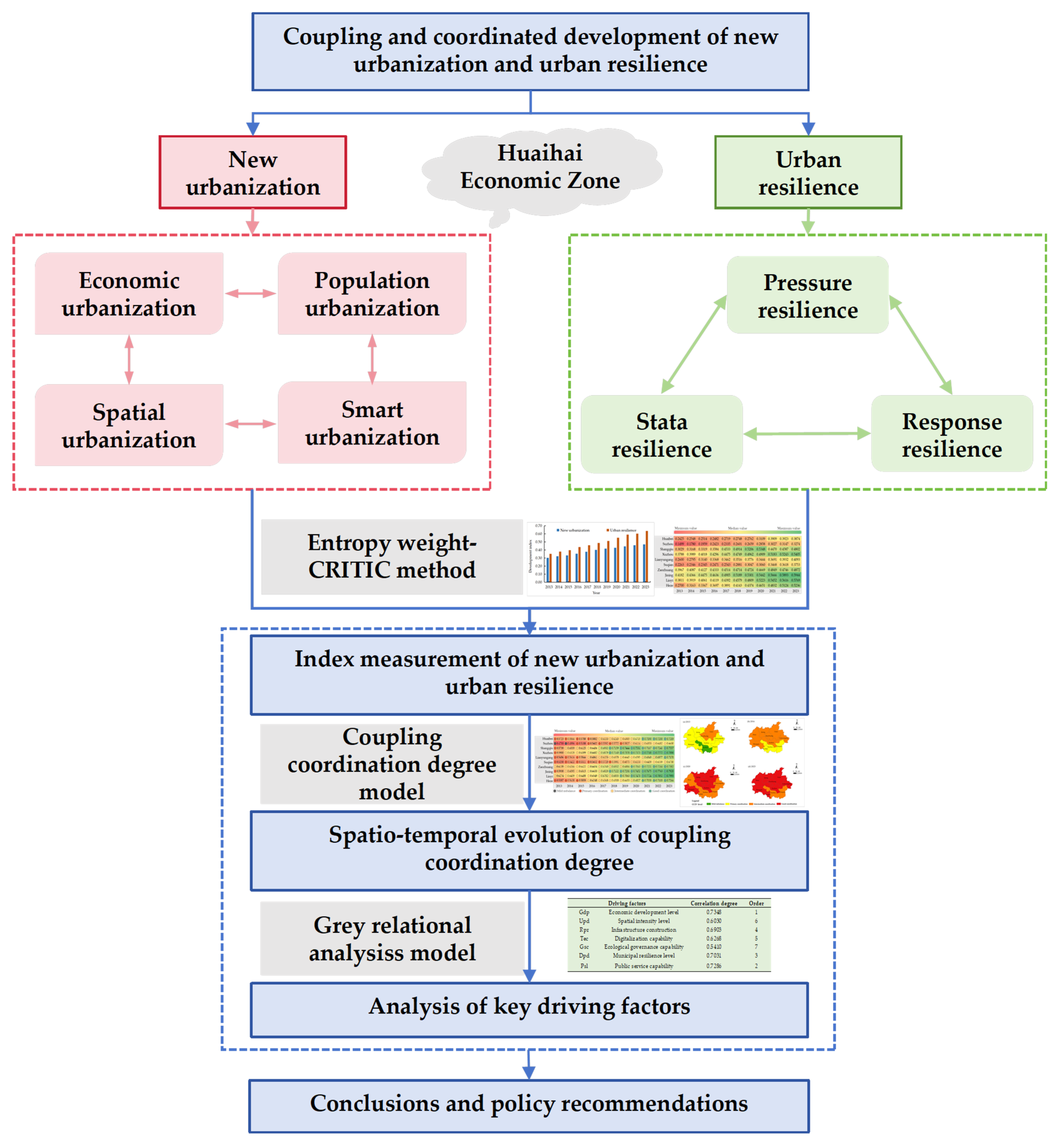

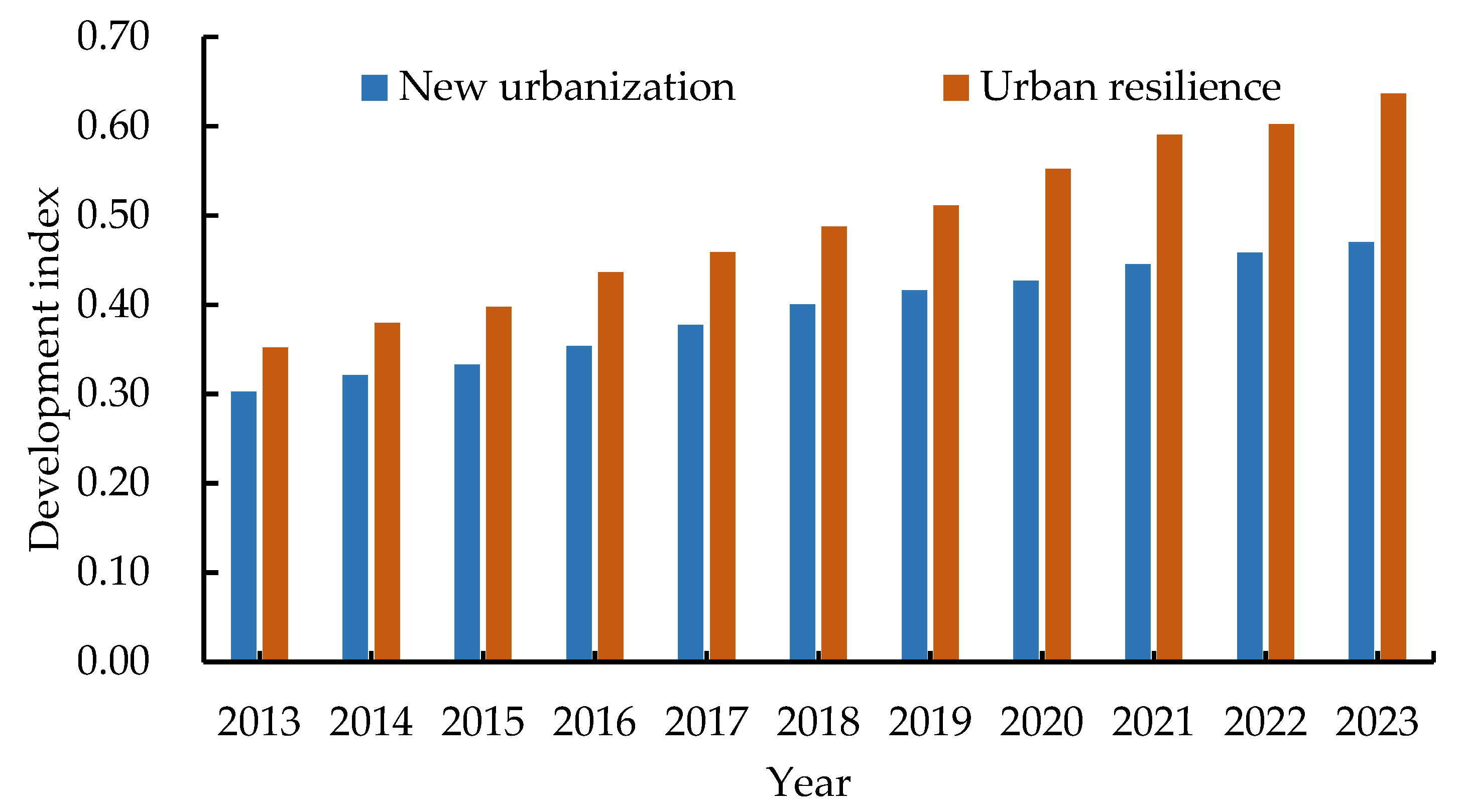
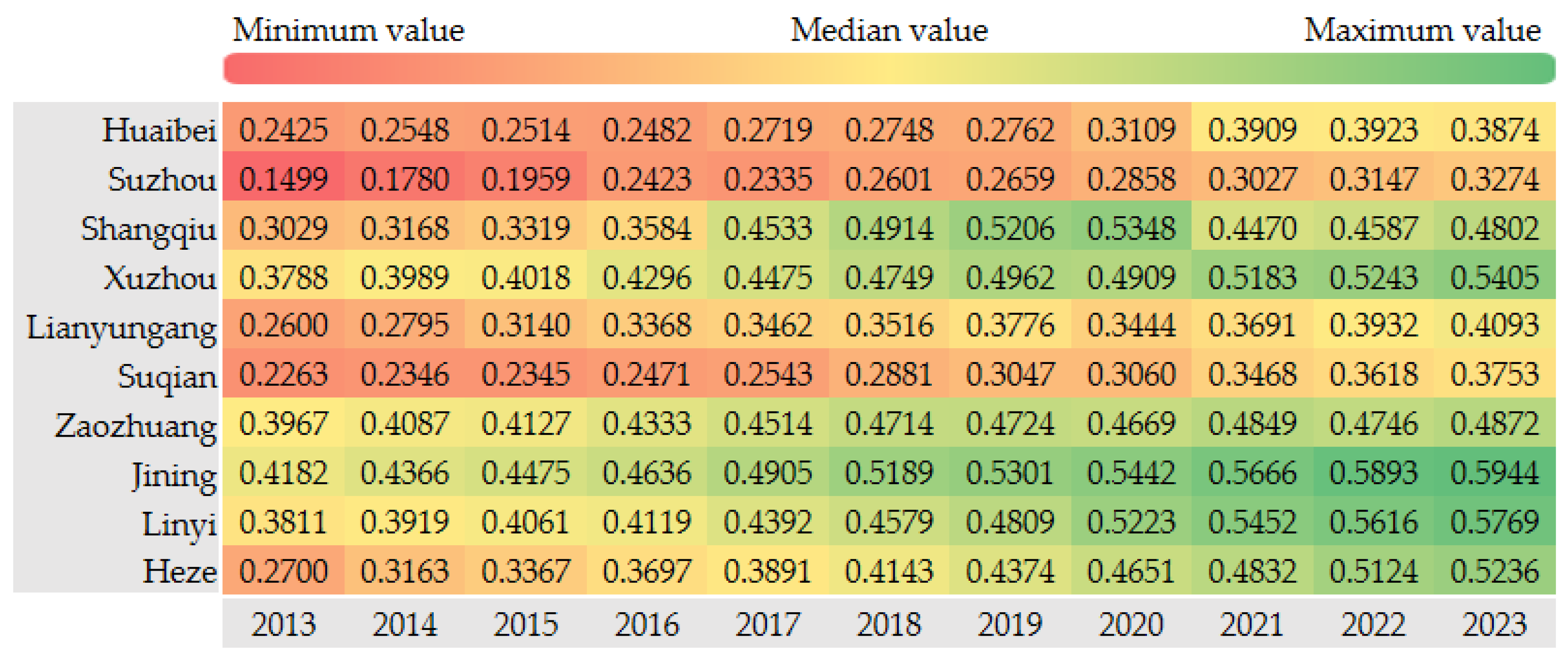


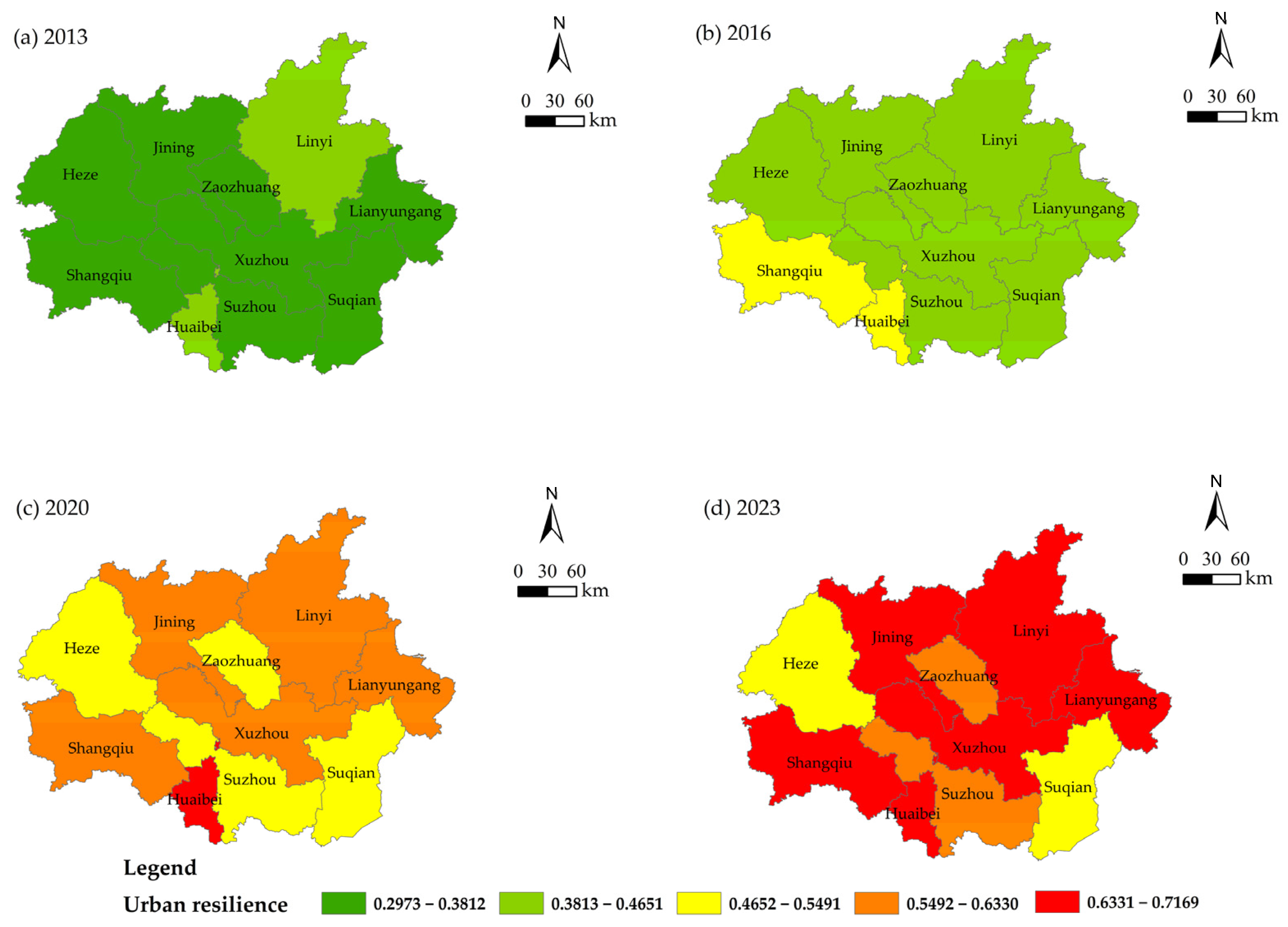
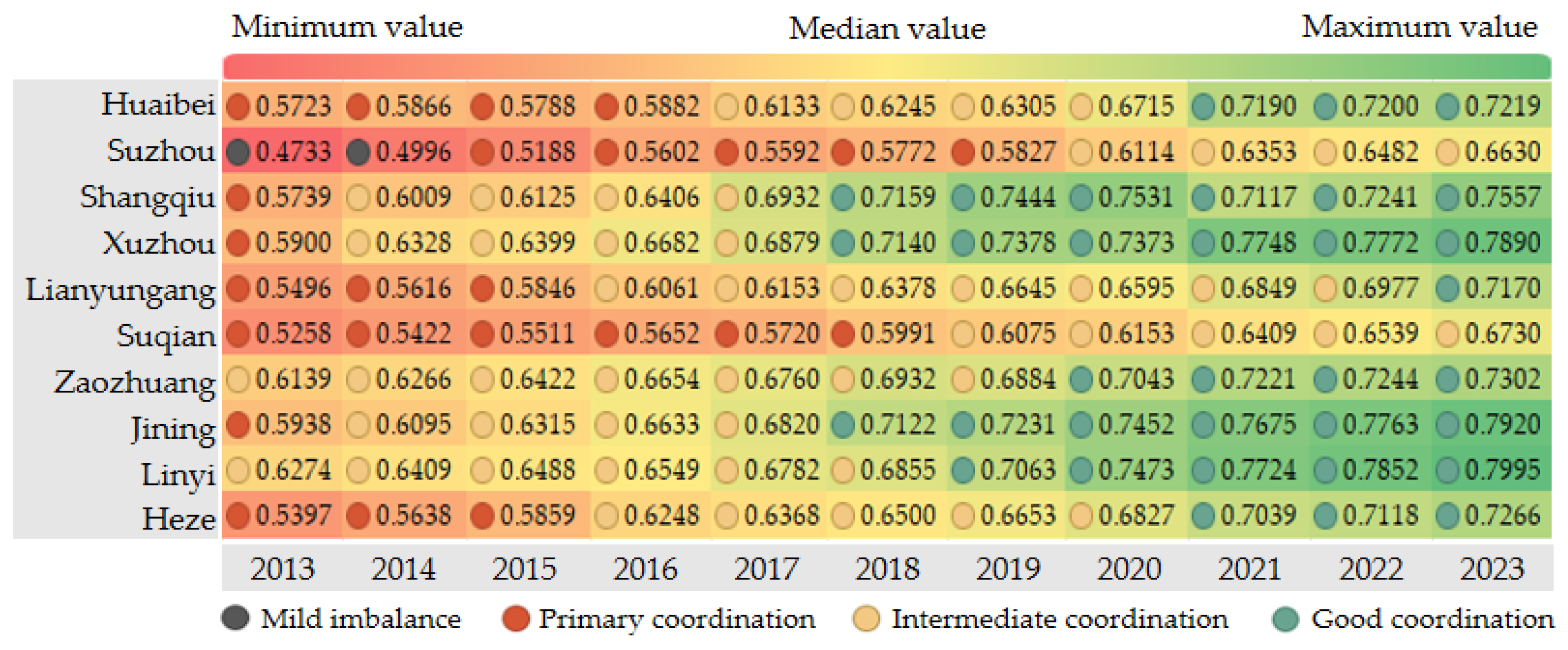
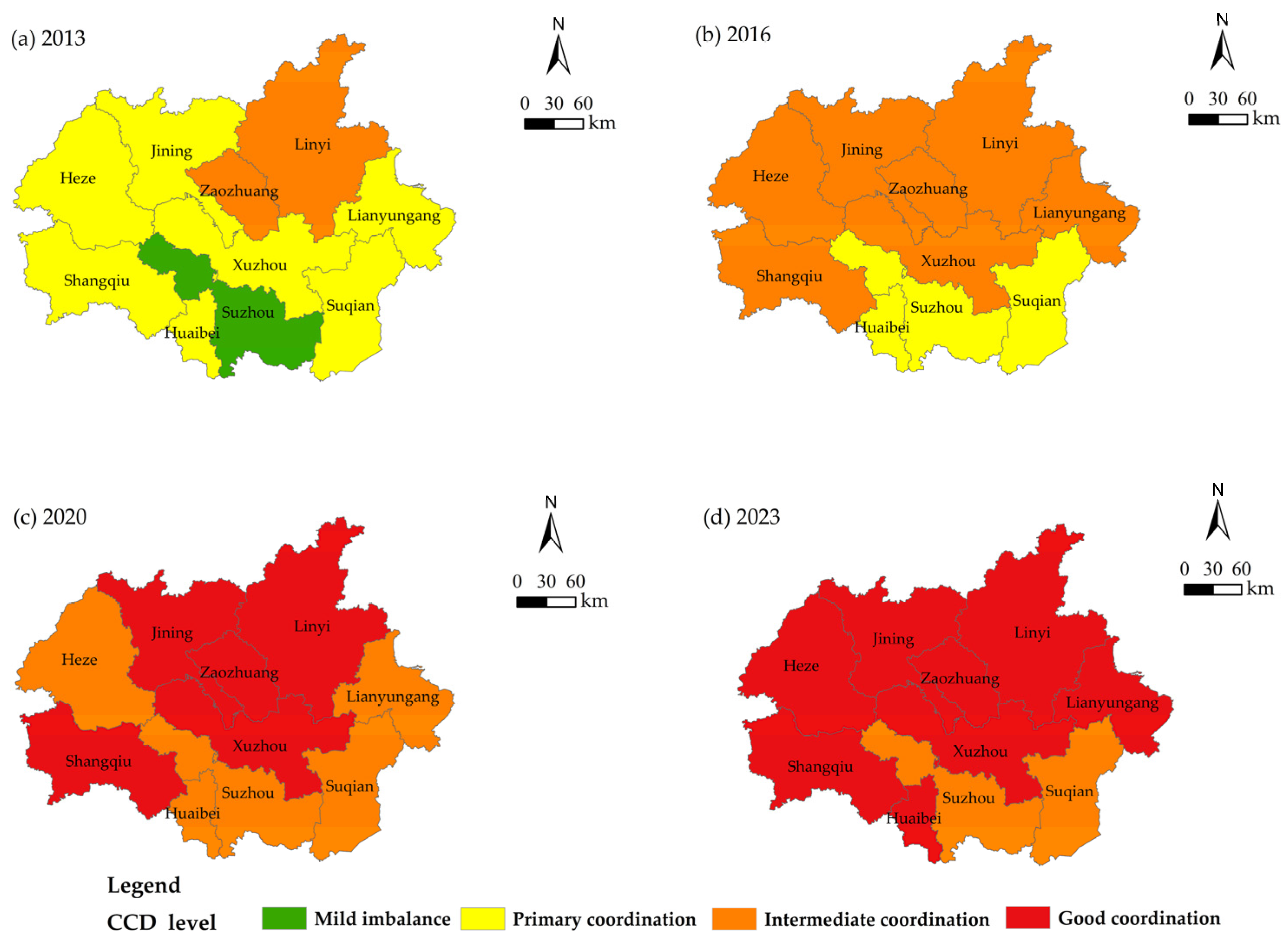
| System | Evaluation Dimension | Indicator Layer | Indicator Direction | Unit | Weight |
|---|---|---|---|---|---|
| New Urbanization system | Population urbanization | Urbanization rate of permanent residents | + | % | 0.0532 |
| Urban population density | + | People/km2 | 0.1690 | ||
| The proportion of employees in secondary and tertiary industries | + | % | 0.0324 | ||
| Economic urbanization | Per capita GDP | + | Yuan | 0.0653 | |
| Proportion of secondary and tertiary industries’ combined output value in the GDP | + | % | 0.0470 | ||
| Per capita consumption expenditure of urban residents | + | Yuan | 0.0480 | ||
| Spatial urbanization | Built-up area | + | km2 | 0.0899 | |
| Proportion of construction land area | + | % | 0.1419 | ||
| Per capita urban road area | + | m2/person | 0.0601 | ||
| Smart urbanization | Year-end mobile phone subscribers | + | 10,000 person | 0.0783 | |
| Number of internet broadband subscribers | + | 10,000 person | 0.1192 | ||
| Proportion of science and technology expenditure in fiscal expenditure | + | % | 0.0956 | ||
| Urban Resilience system | Pressure resilience | Industrial wastewater discharge | − | 10,000 tons | 0.0921 |
| Industrial sulfur dioxide emissions | − | Ton | 0.0616 | ||
| Industrial solid waste generation | − | 10,000 tons | 0.1181 | ||
| State resilience | Per capita disposable income of urban residents | + | Yuan | 0.1144 | |
| The green coverage rate of built-up area | + | % | 0.0387 | ||
| Harmless treatment volume of domestic waste | + | 10,000 tons | 0.1854 | ||
| The density of drainage pipes in built-up area | + | km/km2 | 0.0527 | ||
| Response resilience | Number of higher education students per 10,000 person | + | Person | 0.1520 | |
| Number of health technicians per 10,000 person | + | Person | 0.1205 | ||
| Per capita park green space area | + | m2/person | 0.0646 |
| Driving Factors | VIF | Grey Relational Grades | Order | |
|---|---|---|---|---|
| Gdp | Economic development level | 2.05 | 0.7348 | 1 |
| Upd | Spatial intensity level | 3.41 | 0.6030 | 6 |
| Rpr | Infrastructure construction | 2.25 | 0.6903 | 4 |
| Tec | Digitalization capability | 2.05 | 0.6268 | 5 |
| Gsc | Ecological governance capability | 1.74 | 0.5410 | 7 |
| Dpd | Municipal resilience level | 1.44 | 0.7031 | 3 |
| Psl | Public service capability | 1.72 | 0.7286 | 2 |
Disclaimer/Publisher’s Note: The statements, opinions and data contained in all publications are solely those of the individual author(s) and contributor(s) and not of MDPI and/or the editor(s). MDPI and/or the editor(s) disclaim responsibility for any injury to people or property resulting from any ideas, methods, instructions or products referred to in the content. |
© 2025 by the authors. Published by MDPI on behalf of the International Society for Photogrammetry and Remote Sensing. Licensee MDPI, Basel, Switzerland. This article is an open access article distributed under the terms and conditions of the Creative Commons Attribution (CC BY) license (https://creativecommons.org/licenses/by/4.0/).
Share and Cite
Zhang, H.; Li, S.; Chang, J. Spatiotemporal Evolution and Driving Factors of Coupling Coordination Degree Between New Urbanization and Urban Resilience: A Case of Huaihai Economic Zone. ISPRS Int. J. Geo-Inf. 2025, 14, 271. https://doi.org/10.3390/ijgi14070271
Zhang H, Li S, Chang J. Spatiotemporal Evolution and Driving Factors of Coupling Coordination Degree Between New Urbanization and Urban Resilience: A Case of Huaihai Economic Zone. ISPRS International Journal of Geo-Information. 2025; 14(7):271. https://doi.org/10.3390/ijgi14070271
Chicago/Turabian StyleZhang, Heng, Shuang Li, and Jiang Chang. 2025. "Spatiotemporal Evolution and Driving Factors of Coupling Coordination Degree Between New Urbanization and Urban Resilience: A Case of Huaihai Economic Zone" ISPRS International Journal of Geo-Information 14, no. 7: 271. https://doi.org/10.3390/ijgi14070271
APA StyleZhang, H., Li, S., & Chang, J. (2025). Spatiotemporal Evolution and Driving Factors of Coupling Coordination Degree Between New Urbanization and Urban Resilience: A Case of Huaihai Economic Zone. ISPRS International Journal of Geo-Information, 14(7), 271. https://doi.org/10.3390/ijgi14070271











